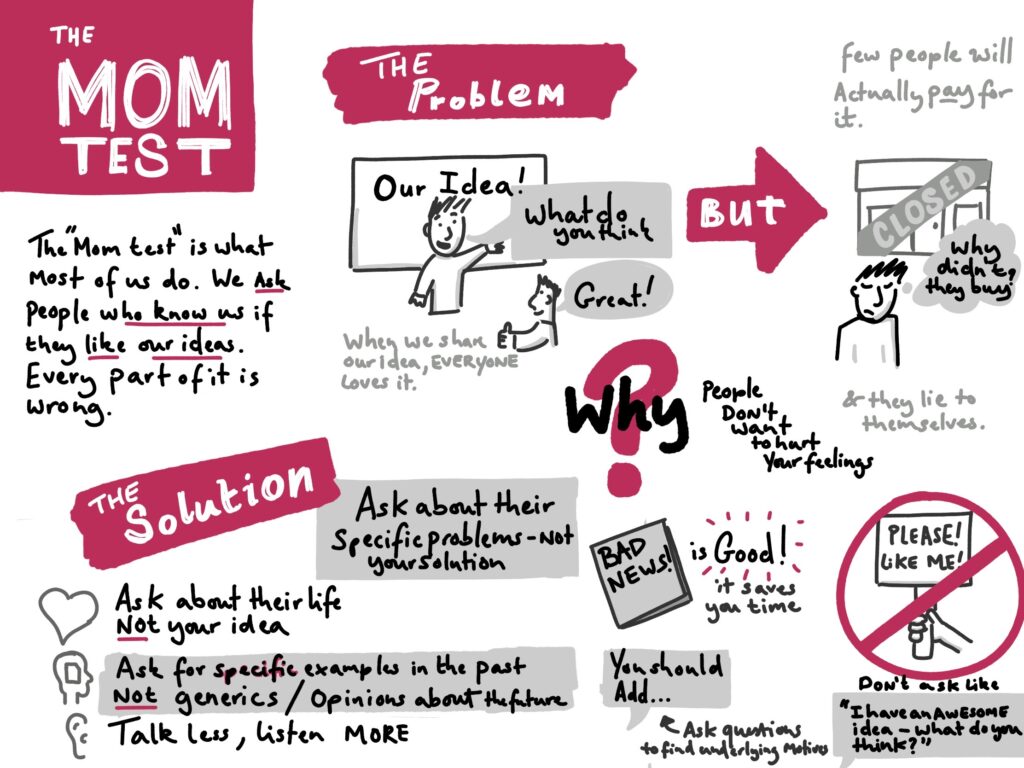What’s the best way to validate a product or service idea? According to author Rob Fitzpatrick it’s the exact opposite of what most of us do. Here’s a quick summary of his book The Mom Test (including a sketchnote) to show you what we do wrong and the right way to act instead.
The Mom Test Sketchnote summary

What is the mom test?
The mom test is the worst thing you can do to validate an idea, and yet it is what most of us do.
It’s when you ask someone you know if they like our idea. It’s called the mom test because it’s like when a mom evaluates their kid’s drawings. They like it because of their relationship with the child and so don’t give it fair evaluation or feedback.
When you rely on the mom test, you fail to properly validate your ideas but get positive feedback. This leads to bad decisions.
What to do instead of the mom test?
Instead of asking if someone like your idea, you should either
- seek to understand their problems, situation and current solutions
- ask them to buy your product or service.
The first helps you get evidence on what the person actually does and needs not what they think they might like. The second proves if they think the idea has value to it and that they would be willing to pay.
How to properly validate an idea
Rather than start with your idea, start by finding out what they are currently doing to solve their problems. You should ask questions to make sure this is a real problem and one that is causing them issues.
While they are answering, look for specific past occasions they have tried to solve their problem instead of generic ideas or opinions about what they’d like. If they can give an example of how they have tried to solve that problem, it proves it is a significant problem. If they haven’t tried to solve it, they don’t care enough.
An anti-marketing approach to sharing your idea
In marketing, you want to share your idea in the best possible light in an attempt to convince someone to buy. When validating an idea, you want to present it as plainly as possible.
State exactly the idea, how it is different, how it works and what it does. Don’t talk about the pain points or how it can help overcome problems with other solutions, be as to the point as possible.
If someone still has a positive reaction to your idea, then you know it’s a good idea. If they have problems or questions about it, don’t be upset.
The value of bad news
Bad news is better than good news.
If you find out there is a similar competitor or another solution which solves the problem better than you could, you have saved yourself from wasting your time.
If someone finds a fault in your product or service, you can now address it. Problems aren’t the end of the discussion.
How to respond to feature requests
Everyone and their dog knows what’s missing from your product or service.
But they’re mostly wrong. Especially when they talk about features.
Your goals is to find out the underlying problem they are trying to address and then work out the best way to address it. This is tightly connected to one of the mom test golden rules.
You cannot tell the customer what their problem is or isn’t, and in return they can’t tell you how to solve it.
If someone tells you they have an issue, accept that feedback. They do have an issue.
Other people might not have the same issue but their problem is real.
But you don’t have to accept their solution.
Get your own copy of the mom test
If this summary and review of the mom test by Rob Fitzpatrick has whet your appetite, you can get your own copy of the book to explore the ideas more.

Leave a Reply